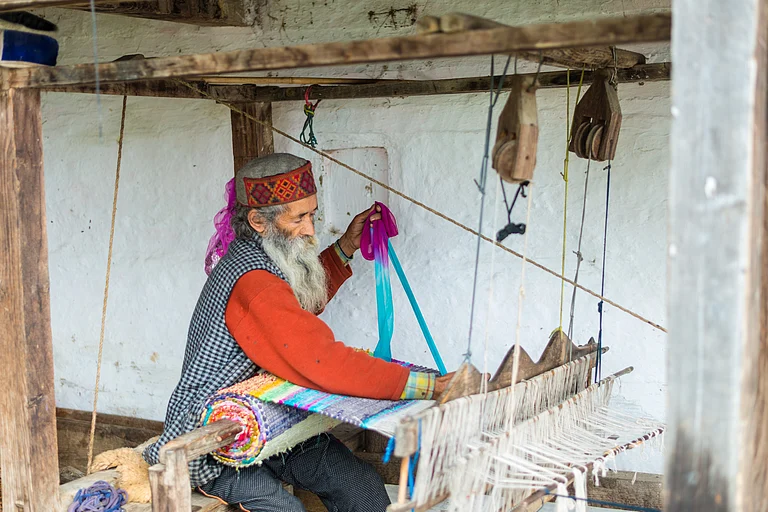The word ‘butterfly’ evokes a sense of frail, fluttery, and gossamer beauty. Her tranquil life seems to consist of only of long hours of swooning over flowers and relishing their sap. However, contrary to popular opinion, they are just moths of the order Lepidoptera possessing highly specialized passive defense mechanisms or toxins. In my recent sojourn to the mountains at Satoli, Mukteshwar, I planned a trip to Bhimtal inspired by a fellow birdwatcher who wished to frame these moths through her camera lens. The Butterfly Research Centre, Bhimtal, is a modest research centre with one of India's most extensive collections of butterflies.
I found an old house nestled between dense oak, Timur berry tree, and other foothill vegetation when I reached the place. In the hall of the house, I saw numerous butterfly specimens preserved and displayed in large glass frames. A mild-mannered gentleman, Peter Smetacek, who had dedicated his entire life to this research, greeted us. He referred to his collection as a ‘reference material’ for researchers. His father, Fred Smetacek, a central European immigrant, had established the butterfly collection at their home in 1946, long before Peter was born. After World War II, the family moved to Naukuchiyatal, Uttarakhand eventually relocating to Jones Estate in Bhimtal in 1951.
Peter is a meticulous lepidopterist and an ardent naturalist. On my flurry of questions, he addressed me as a hasty city-girl and advised me to understand differences in morphology of each species first. When I asked about the British architecture of the house, he told me that the house was built around the 1860s and his father had bought it in 1951. Hence, it was more than 150 years old. Astounded by his acquaintance with zoological nomenclature and his scrupulous scientific approach, I was curious about his education. To this, he said, “I grew up with an existing collection of moths and butterflies on the wall of my father’s room. I took it forward and it has become a significant collection today in the sense that I collected 3500 thousand species out of an estimated 13000-20000 in India. The Forest Research Institute contains 3800 species and Indian Agricultural Research Institute PUSA contains 3200 species of moths and butterflies.”
Peter then told us to turn off our phones. He gave us an overview of the survival strategies and reasons behind the shapes and colours of various species, including the most beautiful ones, such as common peacocks, oak-leaf butterflies, morphos, and silk moths. He extensively spoke about how toxins in some variety and brilliance in colours are an act of passive defense for their predators. He had realized that much work needed to be done, and Indian butterflies had not been cataloged since independence. He added, “The last good book containing all species of butterflies was published in 1932. After that, very few books were published. In 2015, a group of experts published a book titled ‘Synoptic Catalogue of the Butterflies of India.’ Sixteen experts from various countries had compiled it. We compiled information by analyzing the each one’s contribution. For the first time, we discovered that independent India had 1318 species, and it has now gone to 1330.”
I was spellbound to see the shimmering black beauty of Common Peacock, which is the state butterfly of Uttarakhand. Peter then told us that they fed on Timur leaves and can be seen in hundreds on wet mud at a river bank. It is a spectacular sight to watch when seen in swarms, but when one of them flies alone, it looks like a black butterfly. The most intriguing morphology was that of an Oak Leaf butterfly (Kallima), which had the shape of a leaf that contained a drip-tip. The wings of these species change colours according to the climatic conditions. India has four species, and all have pointed forewing tips.
Among all the species, the most economically significant were silk moths. I was surprised to know that all moths producing a good variety of silk in India belong to the order Lepidoptera. The exciting thing about giant silk moths is that they do not have a mouth for food intake. Whatever they eat in the caterpillar stage, they store as fat in their body, and if the fat gets used up, they die. Peter added, “Among the giant silk moths, Atlas moths produce a poor quality silk. India produces five varieties of silk. The first one is mulberry silk, which forms 95 percent of the world’s silk production. The remaining 5 percent includes Moga silk of Assam, the most expensive silk in the world; Eri silk made in Assam; and Tussar silk made in central India.”
Worried about the forest-fires that have destroyed forests of this region in the past few years, he lamented a forest once destroyed can never be recovered as cultivated trees do not contain a rich biodiversity. He said, “I study bio-indicators which mean living indicators. We don’t have any parameter to gauge health of a forest. The forest department tell us that grassland is a forest and we have to believe them because there is no definition of a forest. It is a big joke because if you plant anything it is a plantation not a forest.”
As our conversation ended, the aroma of home cooked food wafted from his kitchen. We now had to stay for the lunch on his insistence and because of that aroma. In that uninhabited jungle, Peter had lived like a scientific monk and preserving the hues, colours, and patterns of the most beautiful moths for many generations of India to come.

























